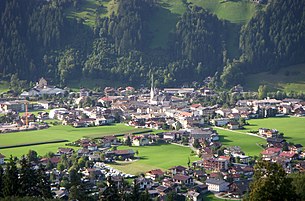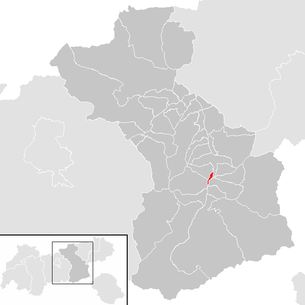Zell am Ziller
|
market community Zell am Ziller
|
||
|---|---|---|
| coat of arms | Austria map | |
|
|
||
| Basic data | ||
| Country: | Austria | |
| State : | Tyrol | |
| Political District : | black | |
| License plate : | SZ | |
| Surface: | 2.42 km² | |
| Coordinates : | 47 ° 14 ' N , 11 ° 53' E | |
| Height : | 575 m above sea level A. | |
| Residents : | 1,716 (January 1, 2020) | |
| Population density : | 709 inhabitants per km² | |
| Postcodes : | 6280, 6283 | |
| Area code : | 05282 | |
| Community code : | 7 09 40 | |
| NUTS region | AT335 | |
| UN / LOCODE | AT ZEZ | |
| Address of the municipal administration: |
Unterdorf 2 6280 Zell am Ziller |
|
| Website: | ||
| politics | ||
| Mayor : | Robert Pramstrahler | |
| Location of Zell am Ziller in the Schwaz district | ||
 Zell am Ziller in September 2008, view from the Hainzenberg |
||
| Source: Municipal data from Statistics Austria | ||
Zell am Ziller is a market town with 1716 inhabitants (as of January 1, 2020) in the Zillertal in the Schwaz district in Tyrol in Austria .
The community is located in the judicial district of Zell am Ziller .
geography
Zell is located in the rear of the Zillertal in a valley basin on the right side of the Ziller . It is the smallest municipality in the valley in terms of area. The surrounding slopes form the communities of Zellberg , Rohrberg , Gerlosberg and Hainzenberg . In the north, the municipality of Aschau im Zillertal , in the south, the municipalities of Hippach and Ramsau im Zillertal adjoin Zell.
Along with Fügen, Zell is the old capital and the economic, administrative and educational center of the Zillertal. These include a branch office of the Schwaz district authority , the district court (all municipalities in the valley belong to the judicial district), the Zillertal tourism schools, a music school, the foundation retirement home and other important institutions.
history
The foundation of the community was laid by monks in the 8th century who converted the inhabitants of the valley to Christianity from the Gerlos Pass and built a simple monk cell.
Zell was of great importance to the Archbishopric of Salzburg . In addition to extensive real estate, there was a direct connection from here over the Gerlos Pass to the Salzburg region.
In 1187 the St. John's Hospital was built for the numerous pilgrims and travelers, from which the foundation retirement home emerged. 1188 the place name Zell as Cellensis parrochia (parish of Zell) in a document of Archbishop Adalbert III. first mentioned in a document by Salzburg. With gold discoveries on the Hainzenberg in the 16th century, the importance of the place increased, so that the administration of the Salzburg court in the Zillertal was relocated to Zell in 1592.
After the decline in mining in the 19th century, Zell was a place of cattle markets. In exchange for wine, the cattle were driven over the Tuxer Joch and the Brenner Pass to Bozen .
In the course of the Napoleonic Wars, Zell was sacked by Bavarian troops on November 6, 1809 during the Tyrolean uprising. After the end of the wars, the Austrian Emperor Franz I paid tribute to the Austrian Emperor on June 5, 1816 , until he traveled on to Fügen , where the local imperial monument was erected. He was an advocate of the participation of the then still Salzburg areas such as Zell in the Tyrolean freedom struggle in 1809 and advocated the unification of these areas with the County of Tyrol.
Miners were still working in the mine until 1930, but mining was discontinued as unprofitable.
In 1989 Zell was raised to a market town.
Population development

Culture and sights
- Parish Church of St. Veit : built in 1779 after a flood spilled the old Gothic church down to the steeple
- Zillertal Regional Museum: offers an insight into historical life. The centerpiece is the “Ental” farm from the 17th century, which was removed from its original location and rebuilt here in 1995. The museum is open in summer.
Regular events
Gauderfest : In Zell the "Gauderfest" takes place annually in the days before the first Sunday of May, which is one of the oldest folk festivals in Tyrol. The name is probably due to the Gauderlehen east of Zell . The focus is on serving the Gauderbock , a bock beer specially brewed for the festival by the local brewery. Other attractions include a parade with floats, music bands and groups in traditional costumes, as well as Ranggeln , a form of wrestling . Animal fights were withdrawn from the program after protests by animal rights activists. In 2014 it was recognized by UNESCO as intangible cultural heritage in Austria .
Economy and Infrastructure
The economy of Zell is characterized by agriculture, various businesses and tourism that has been developing since the beginning of the 19th century.
Tourism schools, where various types of school are offered, are of supraregional importance for training.
With the brewery founded in 1500 ( Zillertal Bier ), Zell is the oldest private brewery in Tyrol.
Due to its economic importance, Zell has numerous commuters.
traffic
Zell is connected to a train station via the Zillertalstrasse and the Zillertalbahn . In an easterly direction, the Gerlosstraße (B165) branches off to the Gerlos Pass (1490 m).
Tourism infrastructure
- Zillertal Arena : The Zillertal Arena was created in 2000 as a merger of the Zell, Gerlos and Königsleiten ski areas and is the largest ski area in the Zillertal. It is accessed by the Rosenalmbahn and, since the 2010/11 season, the Karspitzbahn, whose valley station is in the municipality of Zell.
- Several ski bus lines operate in Zell am Ziller during the ski season.
- If there is enough snow, cross- country trails on the Ziller (classic and sometimes also skating) are groomed.
- Many large soccer teams have a training camp in Zell am Ziller every year.
education
As an important school location, Zell has a new middle school with a focus on music and a polytechnic school . The Zillertal tourism schools enable you to start your career in the hospitality industry. The pupils are qualified for all professions in the hotel and catering sector and some of them complete with a Matura (diploma examination). The regional music school Zillertal is also located in the village.
Others
Zell am Ziller is mentioned in the song Steirermen are very good the Stoakogler .
Personalities
Sons and daughters
- Hans Binder (* 1948), racing car driver and entrepreneur
- Günter Csar (* 1966), Nordic combining
- Martin Egger (1832–1898), Jesuit priest and physicist
- Siegfried Egger (* 1970), hotelier and politician
- Anja Haas (* 1971), ski racer
- Brigitte Hauser (* 1955), ski racer
- Gabi Hauser (* 1958), ski racer
- Thomas Hauser (* 1953), ski racer
- Johann Carl Hocheder (1800–1864), Montanist and mineralogist
- Franz Hörl (* 1956), politician ( ÖVP )
- Johann Damascen von Kleimayrn (1735–1810), Benedictine priest, university professor and last abbot of Wessobrunn
- Johann Franz Thaddäus von Kleimayrn (1733–1805), statesman and scholar from Salzburg
- Josef Mauracher (1845–1907), organ builder
- Balthasar Niederkofler (1906–1989), cross-country skier and ski sports official
- Wolfgang Palaver (* 1958), Roman Catholic theologian
- Helmut Rehm (1911–1991), painter and graphic artist
- Hermann Sander (1840–1919), writer and historian
- Heinz Schiestl (1867–1940), sculptor and graphic artist
- Lisa Ungerank (* 1991), marksman
- Irene Crepaz (* 1945), politician ( SPÖ )
Other personalities in the community
- Felix von Kraus (1870–1937), singer and university professor, retired in Zell and was buried there.
- Adrienne Osborne (1873–1951), singer, lived in Zell and was buried there.
Views
Web links
- 70940 - Zell am Ziller. Community data, Statistics Austria .
- Community website
- History-Tyrol: Zell am Ziller
- Archive recordings from and about Zell am Ziller in the online archive of the Austrian Media Library (radio reports, interviews, folklore film)
Individual evidence
- ↑ Martin Bitschnau , Hannes Obermair : Tiroler Urkundenbuch, II. Department: The documents on the history of the Inn, Eisack and Pustertal valleys. Vol. 2: 1140-1200 . Universitätsverlag Wagner, Innsbruck 2012, ISBN 978-3-7030-0485-8 , p. 338-340, No. 827 .
- ^ Zillertal Regional Museum













